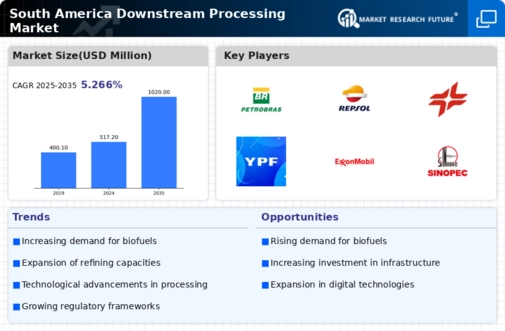Growing Biotech Startups
Biotech startups in South America are reshaping the downstream processing market. These startups are often agile and innovative, focusing on developing novel bioprocessing solutions that cater to local needs. The rise of these companies is supported by various incubators and funding initiatives aimed at fostering entrepreneurship in the biotechnology sector. As of November 2025, it is estimated that the number of biotech startups in Brazil alone has increased by 20% over the last two years. This influx of new players is likely to stimulate competition and drive advancements in downstream processing technologies, ultimately benefiting the entire market.
Increased Focus on Quality Control
Quality control has become a paramount concern in the downstream processing market in South America, particularly as the demand for biopharmaceuticals rises. Companies are increasingly adopting stringent quality assurance protocols to ensure that their products meet regulatory standards and consumer expectations. This heightened focus on quality is likely to drive investments in advanced analytical technologies and process optimization techniques. Recent data suggests that firms prioritizing quality control in their downstream processing operations have seen a 30% reduction in product recalls. Such improvements not only enhance product safety but also bolster the reputation of companies within the downstream processing market.
Regulatory Support for Bioprocessing
The downstream processing market in South America benefits from increasing regulatory support for bioprocessing techniques. Governments are implementing policies that encourage the adoption of biotechnological innovations, which are crucial for the efficient extraction and purification of biopharmaceuticals. For instance, the Brazilian Health Regulatory Agency (ANVISA) has streamlined approval processes for biopharmaceutical products, potentially reducing time to market. This regulatory environment fosters investment in downstream processing technologies, which could lead to a projected market growth of approximately 8% annually over the next five years. Such supportive measures are likely to enhance the competitiveness of local firms in the downstream processing market.
Rising Demand for Biopharmaceuticals
The downstream processing market in South America is experiencing a surge in demand for biopharmaceuticals due to the increasing prevalence of chronic diseases and a growing aging population. This demand is prompting pharmaceutical companies to invest heavily in downstream processing capabilities to ensure efficient production and purification of biologics. According to recent estimates, the biopharmaceutical sector in South America is expected to reach a valuation of $10 billion by 2027, with downstream processing playing a pivotal role in meeting this demand. The need for advanced purification techniques and scalable production processes is likely to propel innovations within the downstream processing market.
Investment in Research and Development
Investment in research and development (R&D) is a critical driver for the downstream processing market in South America. As companies strive to enhance their bioprocessing capabilities, they are allocating significant resources to R&D initiatives. This focus on innovation is expected to yield new technologies that improve efficiency and reduce costs in downstream processing. For instance, recent reports indicate that R&D spending in the biopharmaceutical sector in Brazil has increased by 15% over the past year. Such investments are likely to lead to breakthroughs in purification methods, thereby strengthening the downstream processing market's position in the region.


















Leave a Comment